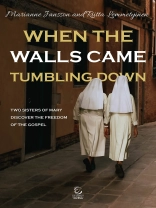‘If the Son makes you free, you will be free indeed (John 8:36).’ Jesus Christ addresses his listeners with this marvellous promise. His message of the Gospel brings people into communion with God and frees them from the bondage of sin, guilt, fear, and despair. At the same time, he establishes the fellowship of believers and unites them by his Spirit and his love: ‘Blessed be the tie that binds our hearts in Christian love; the fellowship of kindred minds is like to that above (John Fawcett, 1782).’ Therefore it is not surprising that people throughout the centuries have been attracted by communities marked by Christian faith, love, and hope. The expectation to believe, live, and serve together within a group of fellow Christians has inspired countless people to join these organizations, some of which have therefore grown to an amazing size.
Obviously, these organizations – like all others – need a certain structure. For whatever reason, this structure is often strongly hierarchical, giving a lot of power to the leader(s). Due to the comprehensive spiritual setting of these organizations, the position (and decision) of the leadership is normally justified by spiritual arguments as well: The leader(s) have been intrusted by God with their responsibility for the group and therefore the members should respect them accordingly and obey their instructions. Unfortunately, there seems to be a tendency that such leadership breaks away from its biblical basis and turns into a kind of authoritarian rule substantiated by Bible verses.
This means that the freedom of the Gospel and the rules of the structure often enter in conflict. If aberrations from the basis of faith in Jesus Christ are detected, they should be corrected. This presupposes, however, that the teachings and rules of these organizations are known and can be verified on the basis of the Bible. From the very beginning the Christians have been exhorted to check the preaching and teaching which they receive from their leaders, whether it matches with the Gospel of Jesus Christ.
The two authors of this book, Marianne and Riitta, have experienced the attraction of Christian fellowship within the Sisterhood of Mary in Darmstadt, Germany. Subsequently, they have lived and suffered the conflict between the spiritually and psychologically rigid structure of the organization and the freedom of the Gospel which they came to know. They describe their experiences of the time after ‘the walls had come tumbling down.’ And they undergo the arduous task to decipher the code of the spiritual system of the Sisterhood and assess it on the basis of the Biblical Gospel.
It is my hope that their work might serve as an example to many Christians to become aware more clearly of the treasure of the Gospel of Jesus Christ. And that this awareness enables them to listen to preaching and teaching more attentively, joining themselves with the people at Beroea who welcomed Paul’s message very eagerly ‘examining the Scriptures daily to see whether these things were so (Acts 17:11).’ If in this way this book contributes to further Christian maturity, Riitta’s and Marianne’s painful pilgrimage would not have been in vain.
สารบัญ
Introduction
Authors’ Preface
Return to the World
How it all Started
Fellowship in Light
The Sources of the ‘Fellowship in Light’
Times of Judgement
Punishment
Mystical Love for God
The Sources of Mystical Love
Asceticism
Brotherly Love
A Significant Letter
A Birthday
Does God Still Suffer?
Take Up Your Cross
Pentecost
Charismatic Gifts
Jesus’ Way: Our Way?
The Shock
Blank Cheque Dedication
Obedience
Training as the Elite Troops
Visions of the Future
The Ideal of Sacrifice
In Norway
Travels in Finland
A New Branch
The Commentary on the Letter to the Galatians
On the Way Out
Our Dear Mother…
The Trip to Darmstadt
Civilians Again
After Effects
Back to College
Discovering the Others
Why Did it all Happen?
Appendix: Short Chronology of the Sisterhood of Mary
About the Authors
เกี่ยวกับผู้แต่ง
Marianne Jansson was born in 1948 in Helsinki, Finland. She graduated from secondary school in 1967 and commenced studying biology in Helsinki University. In 1972 she was awarded a Bachelor of Science degree. From 1973 to 1990 she was a member of the Evangelical Sisterhood of Mary. During her time as a Sister she served in Darmstadt, Germany, from 1973 to 1980, in Norway from 1980 to 1985. From 1985 to 1990 she helped found and run a new branch of the Order in Helsinki, Finland. From 1990 to 1995 she studied Protestant Theology in Tubingen, Germany, and in Helsinki, culminating in a Master’s Thesis on the Teaching and Life of the Evangelical Sisterhood of Mary. This was a collaborative work with co-author of this volume, Riitta Lemmetyinen. Since 1992 she worked within the framework of Finland’s Lutheran Church for the ‘Acacia Foundation, ‘ primarily in Christian adult education.
Riitta Lemmetyinen was born in 1952 in Toijala, Finland. She completed her secondary schooling in 1971. From 1971 to 1990 she was a member of the Evangelical Sisterhood of Mary. During her time as a Sister she served in Darmstadt, Germany, from 1971 to 1980, in Norway from 1980 to 1985. From 1985 to 1990 she helped found and run in Helsinki a new branch of the Order. From 1990 to 1995 she studied Protestant Theology in Tubingen and Helsinki, culminating in a Master’s Thesis on the Teaching and Life of the Evangelical Sisterhood of Mary. This was a collaborative work with this volume’s co-author Marianne Jansson. Since 1992 she worked within the framework of Finland’s Lutheran Church for the ‘Acacia Foundation, ‘ primarily in Christian adult education.












